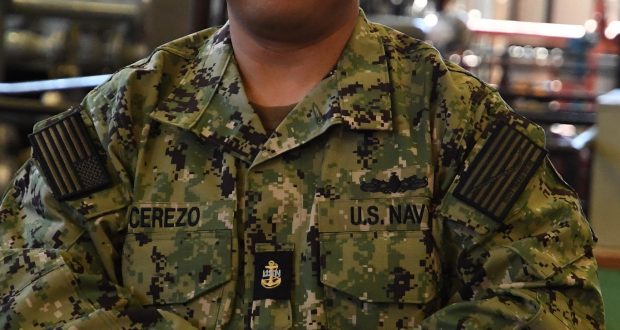By Rick Burke, Navy Office of Community Outreach
GREAT LAKES, Ill. – Sailors are some of the most highly trained people on the planet, and this training begins at Recruit Training Command (RTC) Great Lakes, otherwise known as boot camp. Every enlisted sailor starts their Navy journey at boot camp at Naval Station Great Lakes (NSGL), Illinois.
Chief Petty Officer Laurence George Cerezo, a native of San Bernardino, California, is currently stationed at NSGL as an instructor with Naval Education and Training Command (NETC).
Cerezo, a 1994 graduate of Juan C. Laya San Manuel Pangasinan High School in the Philippines, joined the Navy over 18 years ago.
“I joined the Navy to provide better opportunities for my family’s future with the benefits of military life in both honor and pride,” said Cerezo. “After all, being the fifth generation of my family to join the military, it is significant for me to continue the legacy.”
The skills and values needed to succeed in the Navy are similar to those found in the Philippines.
“The town in the Philippines where I grew up, has taught me the priceless quality of being selfless,” said Cerezo. “Living my childhood in poverty caused me to have the mindset of putting others first, which drives me every day to care. It’s about staying patient, being considerate, being an advocate for myself and striving to help bring out the best in people.”
During the 10 weeks at RTC Great Lakes, sailors learn five warfighting competencies – firefighting, damage control, seamanship, watchstanding, and small arms marksmanship.
NSGL is the Navy’s largest training installation and the home of the Navy’s only boot camp. Located on over 1,600 acres overlooking Lake Michigan, the installation includes 1,153 buildings with 39 on the National Register of Historic Places. NSGL supports more than 50 tenant commands and elements as well as more than 20,000 sailors, Marines, soldiers, and DoD civilians who live and work on the installation.
Two commands at NETC are Surface Warfare Engineering School Command Great Lakes (SWESC GL) and Surface Combat Systems Training Command Great Lakes (SCSTC GL). Every surface Navy engineer, quartermaster, boatswain’s mate and deck seaman attends SWESC GL for technical training. These sailors leave SWESC GL as surface warriors, ready to perform aboard ships operating around the globe. Instructors at SCSTC GL provide a culture of excellence and warrior toughness by building a surface warrior mindset to complement the technical and tactical skillsets.
“The thing I enjoy most about training and mentoring sailors is the challenge of seeing people from different backgrounds with aspects of life and unique individual skills, communicating efficiently to bring their ability to a real-world scenario, such as on deployments or when assigned missions,” said Cerezo. “It’s heartwarming and rewarding in itself to see that I’ve had an impact on students during the weeks we share honing more and more knowledge. I enjoy supporting the command’s mission of Excellence, Ownership and Sustainability (E.O.S.), because my part in bringing capable warfighters, and the next generation of leaders and sailors with bright futures to the fleet, brings feelings of pride to me and my career.”
With 90% of global commerce traveling by sea and access to the internet relying on the security of undersea fiber optic cables, Navy officials continue to emphasize that the prosperity of the United States is directly linked to recruiting and retaining talented people from across the rich fabric of America.
“We will earn and reinforce the trust and confidence of the American people every day,” said Adm. Lisa Franchetti, chief of naval operations. “Together we will deliver the Navy the nation needs.”
Cerezo serves a Navy that operates forward, around the world and around the clock, promoting the nation’s prosperity and security.
“Serving in the Navy means being a part of the larger mission to keep peace among the vast seas warships that come and go for trade, whether it be myself physically serving on a ship or sending others with the knowledge I have given them,” said Cerezo. “It also means the strength of camaraderie between sailors from diverse backgrounds.”
Cerezo is grateful to others for helping make a Navy career possible.
“I will always thank God for giving me the patience to experience life as a Navy sailor,” added Cerezo. “I especially want to thank my wife, Pernita Dabalos Cerezo. She has sacrificed many opportunities, special occasions and her career just to support mine. I would never have served for as long as I have without her being by my side and raising our children, Larence Prinz Cerezo and Larene Precious Cerezo. She has spent all her time raising them and they’ve become my pride and joy. Lastly, I would like to thank my friends and relatives who have supported me throughout my Navy career.”
 Westside Story Newspaper – Online The News of The Empire – Sharing the Quest for Excellence
Westside Story Newspaper – Online The News of The Empire – Sharing the Quest for Excellence





